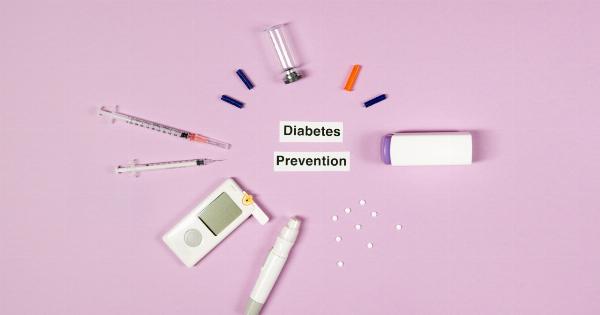Type 2 diabetes is a chronic condition that affects millions of people worldwide. It is characterized by high blood sugar levels resulting from the body’s inability to use insulin effectively.
While there are several risk factors for developing type 2 diabetes, adopting healthy lifestyle changes can significantly reduce your chances of developing this condition. In this article, we will discuss four simple steps that you can start implementing today to prevent type 2 diabetes.
1. Maintain a Healthy Weight
Excess weight, especially around the waist, is one of the primary risk factors for type 2 diabetes. Obesity increases insulin resistance and impairs glucose metabolism, leading to elevated blood sugar levels.
By maintaining a healthy weight, you can reduce the strain on your body and lower your risk of developing diabetes.
To achieve and maintain a healthy weight, it is important to combine a balanced diet with regular physical activity. Focus on consuming a variety of nutrient-dense foods, such as fruits, vegetables, whole grains, lean proteins, and healthy fats.
Limit the intake of processed foods, sugary beverages, and foods high in saturated and trans fats. Additionally, engage in at least 150 minutes of moderate-intensity exercise per week, such as brisk walking or cycling.
2. Follow a Balanced Diet
The food you eat plays a crucial role in your overall health and well-being. By following a balanced diet, you can help prevent type 2 diabetes. A balanced diet consists of adequate amounts of carbohydrates, proteins, fats, vitamins, and minerals.
Opt for complex carbohydrates like whole grains, legumes, and vegetables, as they have a lower impact on blood sugar levels compared to refined carbohydrates. Include lean sources of protein, such as poultry, fish, beans, and tofu.
Incorporate healthy fats like avocados, nuts, and olive oil into your meals. These fats can improve insulin sensitivity and help regulate blood sugar levels.
It is also important to limit your intake of sugary foods and drinks. These can cause rapid spikes in blood sugar levels and increase your risk of developing diabetes.
Instead, satisfy your sweet tooth with natural alternatives like fruits or opt for sugar substitutes in moderation.
3. Get Regular Physical Activity
Physical activity is not only important for maintaining a healthy weight but also for preventing type 2 diabetes.
Regular exercise helps your body utilize insulin more efficiently, improves blood sugar control, and reduces the risk of developing diabetes.
Engaging in both aerobic exercises and strength training is crucial. Aerobic activities, such as walking, jogging, swimming, or dancing, improve cardiovascular health and help regulate blood sugar levels.
Strength training exercises, like lifting weights or using resistance bands, increase muscle mass and improve insulin sensitivity.
Strive for at least 30 minutes of moderate-intensity exercise on most days of the week. If you are just starting, begin with shorter durations and gradually increase the intensity and duration as tolerated.
Remember to consult with your healthcare professional before starting any new exercise program.
4. Manage Stress Levels
High levels of stress can contribute to the development of type 2 diabetes. When you are stressed, your body releases hormones that can increase blood sugar levels.
Chronic stress can also lead to unhealthy coping mechanisms like emotional eating or a sedentary lifestyle, which further raise the risk of diabetes.
To manage stress effectively, incorporate stress-reducing techniques into your daily routine. These may include meditation, deep breathing exercises, yoga, spending time in nature, or engaging in hobbies.
Finding healthy outlets for stress can help you maintain a balanced lifestyle and reduce the risk of developing diabetes.
In conclusion, preventing type 2 diabetes involves making positive lifestyle changes, such as maintaining a healthy weight, following a balanced diet, engaging in regular physical activity, and managing stress levels.
Remember that small steps can lead to significant improvements in your overall health. Start implementing these four simple steps today, and take control of your future by reducing your risk of developing type 2 diabetes.






























